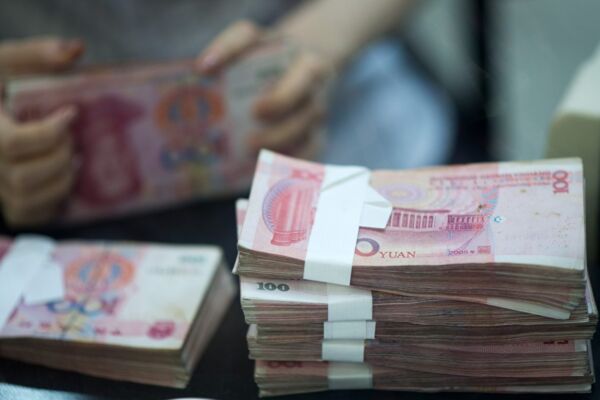According to official data, in the first seven months of this year, the total amount of local government bonds issued by the Chinese Communist Party (CCP) amounted to approximately 4.2 trillion yuan. Of this, around 2 trillion yuan was used for refinancing bonds to repay existing debts, while about 60% of newly issued bonds were earmarked for investment in infrastructure projects. The substantial risk posed by the “borrowing new to repay old” practice of local CCP debts, particularly in urban investment debts, continues to draw attention.
Citing data from China’s Ministry of Finance, mainland media outlet “First Financial” reported that from January to July this year, local CCP governments issued a total of about 4.2 trillion yuan in bonds, with bond issuance reaching 903.6 billion yuan in May, the highest monthly volume in the first half of the year.
Public records show that out of the total 4.2 trillion yuan issued, around 2 trillion yuan was raised through refinancing bonds. Refinancing bonds are characterized by the practice of using borrowed funds to repay maturing debt principal or existing debts.
The report noted that in recent years, some regions have faced larger amounts of maturing debts, leading to higher levels of refinancing bond issuance to prevent and manage debt risks.
Of the newly issued 2.2 trillion yuan in bonds, approximately 1.8 trillion yuan was allocated to specific-purpose bonds, while the remaining 0.4 trillion yuan was for general-purpose bonds. Among the funds from specific-purpose bonds, around 34% went towards municipal and industrial park infrastructure, followed by investments in transportation infrastructure such as railways, toll highways, and mass transit, accounting for 20%. Other allocations included shantytown renovations (about 9%), healthcare (approximately 7.5%), and agriculture, forestry, and water conservancy (5.4%).
The report quoted Wen Bin, chief economist at China Minsheng Bank, who highlighted that infrastructure remains a key focus area for specific-purpose bond investments. Funds raised for infrastructure projects through specific-purpose bonds in the first seven months of this year accounted for 68.2% of the total, marking a 5.1 percentage point increase from last year.
It is indicated that the current legal channel for local governments to borrow money is by issuing local government bonds. Against the backdrop of growing financial tensions at the local level, regions increasingly rely on bond issuances to raise funds for major projects. It is projected that the issuance speed of local debts will significantly increase from August to October, reaching a peak for the year.
Externally, it is believed that the greater debt risk for the CCP lies in local implicit debts, primarily urban investment debts. However, there is a lack of accurate data on these debts, which are not reflected in official financial records.
According to data from China’s Ministry of Finance, by the end of December 2023, the balance of local government debts stood at 4 trillion yuan. Yet, in August 2023, Goldman Sachs estimated that accumulated local CCP government debts could reach as high as 9.4 trillion yuan, including debts from local government financing platforms, which are off-balance-sheet liabilities.
Local financing platforms have been dubbed as “black holes” in China’s financial system by industry experts. A previous report from the China Banking Research Institute stated that debt from urban investment platforms amounts to hundreds of billions of yuan, posing a systemic risk to the CCP’s financial stability.
Urban investment debts are often rolled over through the “borrowing new to repay old” method, wherein the principal keeps accumulating through new borrowings while debt interest must be paid. Taiwanese economist Sun Guoxiang pointed out to the Epoch Times earlier that urban investment companies can raise funds through bond issuances, creating a situation where financial institutions have significant exposure to their loans. If this leads to debt defaults triggering a chain reaction, it could shake market confidence in local governments and urban investment companies, impacting the overall stability of the financial market.

